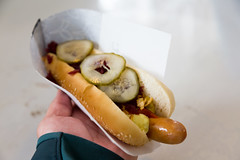Sadly, after our trip to Viðareiði, it was time to head back to our Airbnb in Svínáir, have one last night gazing over the Sundini Sound while enjoying the late night sun, and then pack up and head off to the airport (a journey of multiple bridges and tunnels). Our last stop before the airport was heading into nearby Sørvágur to fill up the tank on the rental car, and that brings me nicely to a last little topic on Faroese dining: Gas Stations.
One mildly frustrating aspect as a tourist is that the Faroes still follow old-school European shopping hours. By that, I mean that that most everything closes implausibly early, despite the late summer sun. So evening hours for businesses are pretty rare, and most everything much more limited on Saturday. On Sunday, a substantial fraction of places are closed. Add into that, aside from the major towns (Tórshavn and Klaksvík), most of the towns don’t have much in the way of retail, grocery, or light sundries. But that doesn’t mean that people do without. Like Iceland, there’s one common institution that that is there to serve you when most everything else is closed, or you need some food when no other restaurant is to be found. That’s the gas station.
Particularly the Effo brand. With about a dozen or so locations scattered around the Faroes, it’s the major gas station brand. Much like N1 is ever-present in Iceland, you’re never that far from an Effo. And, like many a US gas station like Sheetz, there’s plenty going on at Effo. You can buy your gas, of course. You can also buy stamps, pay the tolls for the tunnel tolls if you rental agreement doesn’t cover them. You can buy stamps. You can buy light groceries. And, at several locations, like Leirvík, you can even buy… yarn. But aside from the gas and light snacks, there’s one more thing that you can pretty much always buy at an Effo, and that’s a hot dog.
Like Iceland and Denmark, the Faroe Islands loves their hot dogs. The Faroese hot dog, or pylsa, is served up near identically to the Danish tradition (for that, I refer you to our review of Annie’s Kiosk in Denmark), with ketchup, mustard (sweet German-style), remoulade sauce, crispy fried onion bits, raw onion, and lightly-pickled cucumber slices. But, in a nod to the local food tradition, the hot dog itself is more likely to be a lamb dog than a beef or pork one, much like the splendid pylsurs of Iceland. Offered up either on a bun with toppings, or as a “Fransk pylsa” (French hot dog), served up with sauce slathered on it and inserted into a hollowed-out loaf of bread (indeed, I’ve seen these both in Denmark, and in France). The result is quite good: the hot dog itself is a pleasant natural casing dog with a lot of meat flavor and a nice snap, and the various Danish-style toppings add a lot of dimension. I’m actually surprised that I didn’t eat more of these.
So, with our hot dogs finished, and a few minutes spent filling out some postcards and affixing the philatelically-valuable Faroese stamps to them for mailing to friends and relatives, we then took our car back to the airport. We soon found ourselves back in the air and enroute to Edinburgh, bidding adieu to the wonderfully scenic Faroes. I hope some day I get to return and explore some of the other sights and islands.





